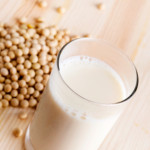- Soy is a great protein source, especially for vegetarians who do not eat meat.
- Soy provides the body with calcium and iron as well as other important vitamins and minerals
- Soy can be found in plant-based foods including soybeans and products made from soybeans like soymilk and tofu.

Soy refers to products such as soy milk, cheese, yogurt, tofu, ice cream, and other foods that are made from soybeans. While soy foods have become more popular in the United States over the years, people in Asia have eaten soybeans for hundreds of years.
What are the health benefits of soy?
Soy is rich in protein, vitamins, and minerals such as as calcium and iron. Soy contains heart-healthy fat and is low in saturated fat.
Where can I find soy foods?
Foods containing soy can be found at most local grocery stores, health food stores, or Asian grocery markets. Here is a list of some different soy foods:
| Soy Food | Description |
| Edamame (green soybeans) | Edamame can be eaten as snack or meal after steaming or boiling them in lightly salted water for 15-20 minutes. |
| Dairy-free soy yogurt | Soy yogurt is a great alternative to dairy yogurt. In terms of protein, it is more comparable to cows milk yogurt that other alternatives. |
| Hydrolyzed vegetable protein | Hydrolyzed vegetable protein is made from soybeans and other vegetables. It can be added to soups or casseroles to add protein and flavor. |
| Miso | Miso is a paste made from soybeans, grain, and salt. Miso can be used to make soup or sauces. |
| Dairy-free soy cheese | Soy cheese is made from soy milk and can be used as a substitute for sour cream, cream cheese, or cheese. |
| Soy flour | Soy flour is made from ground roasted soybeans. Soy flour can be added to baked goods to add protein. However, soy flour cannot be used as a complete substitution of all flour in a recipe because it doesn’t contain gluten, which is a protein that helps dough rise, and it will not produce the same texture in baked goods. As a general rule of thumb, soy flour can be substituted for up to 1/3 cup of regular flour. |
| Soybeans | Whole soybeans can be soaked and added to stews and soups for flavor and protein. They can also be roasted for snacks (known as soy-nuts) |
| Soymilk | Soymilk is made from soybeans that have been soaked in water, ground, and strained. Fortified soy milk (which has added calcium and vitamin D) can be used instead of dairy milk as a drink, in cereals, and in other recipes. Soy milk comes plain and in different flavors such as chocolate and vanilla. It is a good alternative to milk for someone with lactose intolerance or milk protein allergy as it is comparable in protein and calcium content. |
| Soy nut butter | Soy nut butter is made from roasted whole soy nuts, which are crushed and blended with soy oil. The butter can be used in place of peanut butter and is a good substitute for people who are allergic to nuts. |
| Tempeh | Tempeh is made from fermented soybeans and grain. Tempeh can be marinated and grilled and added to soups, casseroles, or chili. |
| Textured soy protein, textured vegetable protein (TSP/TVP) | Textured soy protein/textured vegetable protein is made from soy flour. It’s most often used with, or instead of, meat in casseroles or other dishes. If TSP/TVP is substituted for meat, other flavorings then need to be added. TSP/TVP can be bought as dried kernels and then prepared with boiling water. |
| Tofu | Tofu is made by curdling fresh, hot soy milk. Firm tofu can be used in soups, stir-fries, and casseroles. It can be baked or grilled and will take on the flavor of a sauce or seasoning. Silken tofu can be used for dips and dressings. |
What is soy protein isolate?
Soy protein isolate is made from defatted soybean flour, and is a highly processed form of protein. During processing, all the great nutrients found in soybeans are stripped away, leaving only the protein. Soy protein isolate may also contain chemical additives and could potentially upset your stomach. Soy protein isolate is used in many vegan/vegetarian products, protein bars, baked goods, and breakfast cereals
Nutrition facts for soy foods:
| Soy food | Protein | Calcium | Iron |
| Green soybeans (“edamame”), cooked (1/2 cup) | 1o g | 60 mg | 2 mg |
| Fortified soymilk (1 cup) | 7 g | 300 mg | 1 mg |
| Soy cheese (1 oz) | 4 g | 160 mg | 2 mg |
| Soy flour (1/2 cup) | 15 g | 87 mg | 3 mg |
| Soy nut butter (2 Tbsp) | 7 g | 30 mg | 1 mg |
| Soy nuts (1/4 cup) | 9 g | 30 mg | 1 mg |
| Tempeh (1/2 cup) | 17 g | 92 mg | 2 mg |
| Textured vegetable protein (1/4 cup) | 12 g | 80 mg | 3 mg |
| Tofu, firm (1/2 cup) | 11 g | 253 mg | 2 mg |
Easy ways to incorporate soy into your diet:
- Try soynut butter instead of peanut butter
- Use tofu or tempeh in stir-fries to add protein
- Try snacking on soy nuts, or mix some into a trail mix
- Substitute soy milk for dairy milk
 Young Men's Health
Young Men's Health
